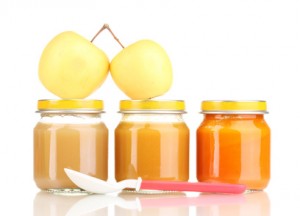
Getting your kids to eat healthy foods is one of the many challenging aspects of parenthood. I’ve been with clients’ kids at mealtimes, and I know how the best-intentioned parents can cave into sugary treats and pasta yet again to get their kid to just eat something. I’ve also prepared food for the kids, and I know how picky they can be!
But ensuring your children eat a healthy diet is an extremely important responsibility as a parent, however, because we develop our flavor preferences and eating habits in childhood. Getting your kids off to a healthy start can affect their eating habits and health for the rest of their lives.
When Do Preferences Develop?
Just when do kids actually begin to develop their flavor preferences? Researchers from the Monell Chemical Senses Center sought to answer just that question, and determined that flavor preferences can develop in the first four months of life. The foods a mother chooses while breastfeeding pass on to the child via breast milk, which can cause flavor preferences for certain foods to develop.
Similarly, another study by the Eating Behavior and Child Development Center found that while breastfeeding does help infants initially accept new foods, this only occurs if the food is something the mother eats regularly. Following weaning, children need repeated exposure to foods in order to develop a taste for it. So don’t give up if your child doesn’t drink the GGS or eat salad right off the bat! Keep trying. I have personally seen lots of young children slurp their GGS down. You can tell them it’s a green superhero drink or just put another banana in it. Or if you start early enough, a green drink isn’t anything out of the ordinary in the first place!
Tips for Helping Your Children Develop Healthy Food Preferences
Laying the foundation early can result in a lifelong habit of making healthier choices. As a parent, you have more influence in your child’s flavor preferences than you might imagine. Here’s how you can help your kids develop healthier eating habits and flavor preferences.
1. Start with what you eat when you’re pregnant.
Studies have shown that what a mother eats during pregnancy can also affect her child’s acceptance of new foods during weaning. Many mothers ask what to eat during pregnancy and the answer is simple: organic and green! It’s important for a fetus’s growth and development, but they may be less aware that the foods they choose will also affect how willing their child is to eat new foods as they are weaned. It’s much easier to introduce flavors like kale and greens by eating them yourself when you are pregnant than it is repeatedly exposing your child to that new flavor over time later in life. The bottom line? Eat lots of healthy plant foods and drink the Glowing Green Smoothie when you are pregnant and you’ll not only get your baby off to a great start health-wise, but you’ll also help them develop a preference for healthier foods.
2. Breastfeed, and eat healthy foods when you do.
Breastfeeding not only gets your child off to a healthy start by strengthening his or her immune system and reducing potential future food sensitivities, but it also gives you further opportunity to develop your child’s taste for healthy foods. If you are feeding your child formula, you’ll have far less influence on the development of taste preferences. Eating healthy, raw plant foods not only helps make your breast milk super nutritious for your baby, but it also exposes him or her to the flavors of healthy foods, allowing your child to develop a lifelong love of foods that are good for him! If you are a working mother, you can still give your child the benefit of breastfeeding. Many commercial breast pumps are very efficient and allow you to collect and store milk for your child while you are at work.
3. Don’t wean too soon
The American Academy of Pediatrics recommends breastfeeding your child for at least 12 months, while the World Health Organization recommends breastfeeding for the first two years of life. Breastfeeding for the first one to two years of your child’s life allows you a significant period of influence in developing flavor preferences. I know this isn’t possible for many mothers, but do your best.
 4. Make your child’s first solid foods pureed vegetables
4. Make your child’s first solid foods pureed vegetables
Many parents start their children on solid foods at about 4 to 6 months. In many cases, the first food offered is a grain cereal such as rice cereal. Feeding your children these white foods at an early age, however, can be disastrous for developing flavor preferences. Most white grain cereals are sweet and bland, and introducing them to your child at four months can develop a taste for white foods, which have very little nutrition. Instead, offer your child pureed vegetables at an age when he or she can tolerate them – usually at about the age of six months – as their first food. Try making pureed yams, sweet potatoes, carrots, etc.
5. Don’t give your child juice, soft drinks, or sugary foods
Offering a child anything sugary or sweet can override their desire for other flavors. You can give your child some pureed fruit when he or she is physically ready to eat it, but make this only a small part of his or her diet. Children should drink water. When did the whole juice at every meal and snack time thing get started? It just loads them with pure, liquid sugar.
6. When you do introduce grains, make them whole, non-gluten grains
Avoid white flour and processed grains, as well as wheat, barley, rye, and oatmeal that isn’t labeled gluten-free. Try grains such as quinoa, brown rice, and amaranth instead. These are rich in minerals and nutrients and save all the potential issues of wheat and gluten.
7. Continue to offer healthy foods, even if your child doesn’t like them at first
As your child grows, the best way to develop healthy flavor preferences is repeated and consistent exposure to the foods you’d like her to eat. Offer the food and allow your child to see you eating it, as well. Monkey see, monkey do!
Developing healthy flavor preferences in your child lays the groundwork for healthy eating throughout life and will help them reach their full potential in all aspects of their life. Give your child the best start possible by helping him or her establish a healthy palate…they’ll thank you later!


 4. Make your child’s first solid foods pureed vegetables
4. Make your child’s first solid foods pureed vegetables
Love that you mentioned not weaning to soon… Have you heard of child led weaning? It’s definitely something to look into… Not only the the Bfeeding part, but with introducing foods as well. I believe that if it has to be pureed, the kid isn’t ready to eat solids. Gorillas are born with blenders, are they? Ha! If you want to look into it, I am pretty sure there is a book titled “child led weaning”… And you can always google it.
Great post, Kim! It’s so important to start healthy as soon as possible! And it’s never too late to start either! :) Absolutely loved reading all these ideas, they are extremely practical and applicable. xo
When my kids were ready to eat, we were fortunately steered away from all those “first cereals” which are full of gluten and devoid of real nutrition. Instead avocado was high on the list of first foods. Since the brain is largely made of fat, the healthy fat in avocado actually nourishes brain development. Plus it’s the perfect consistency for a child figuring out what to do with new substances in the mouth.
Hi, Kimberly,
Thank you for the advice!
As a mom of twin boys and expecting a third one I do try my best to feed my boys and myself a healthy diet. I am convinced that starting to drink the GGS on a regular basis helped me get rid of some food allergies (I could not eat most of the fruits, like apple, pear etc., and now I can!)
However, I just wanted to add something about kids’ eating habits. I just read and article of Eda LeShan from her book “When your Child drives you crazy” about kids not wanting to eat, and that helped me relax a little bit about children’s feeding time. Turns out if you let children decide what to eat (whithin reason, of course) starting at age 2 1/2 and on, they will eat a balanced and nutritious diet overtime! And eating is just not interesting enough for them until the age of 6 or later, when they can actually sit down for more than 2 minutes at a time :), so even eating in front of a TV at young age will eventually go away as children get older.
About eating while pregnant. Craving, turns out, is a BIG thing and it might let you know what children would like when they get born. With my first pregnancy I was craving salads (!) and miso soup, and that’s what my twin boys like to eat. With the second one it’s mostly pickled and spicy stuff, and animal protein – I do not feel satisfied until I eat some meat. I think, partly it is because I ate so many salads right before pregnancy, and my body just needed something else. I would like to eat more plant-based protein, but I can’t – I am allergic to nuts and seeds and protein-rich plants in general. Also, please ask your friend who gives advice to pregnant women (green baby) to stop telling pregnant women not eat after 6 pm. Pregnant women have different needs, and unless you have been pregnant yourself, you have no idea, how a pregnant woman feels when she is hungry, and it does not matter what time of day or night it is.
Again, thank you for your articles and your books. They do help me make healthier choices for myself and for my family.
Olga.
Hi Kimberly!
This is another interesting blog entry! I follow the BDS and have an 8 month old daughter. It is so important to me that she eats as healthy as possible to develop good habits for life as I grew up being quite over weight and completely changed my lifestyle 3 years ago. I actually never did purées for my daughter, we followed the “Baby Led Weaning” approach (the book is by Gill Rapley) where the baby teaches his/herself to eat, how much to eat etc. Definitely look into it as it’s a fantastic way to introduce foods for babies which I think is absolutely essential to setting a good foundation for healthy eating for life…Payton eats everything we eat and loves it!
Hi
I have been teaching healthy cookiing to kids for the past few years in San Francisco. I find that the children eat the vegetables that we make together with great gusto.. I tell people I feel like I am making M and M’s. We usually roast veggies or make salads or soups. I am a RN with many years of working with the sick. I only want to work in the arena of Health Promotion and Disease Prevention. Unfortunately the health care system still pays for illness.
Susan Evans RN MSN
Great post, Kimberly! My boyfriend and I were talking about this very thing a few days ago. I love the new information you provide regarding tastes being acquired while children breastfeed. This is definitely a great article for new and expectant mothers. :)
My 3yr old daughter is finally drinking about 6oz of GGS daily! W/o any fight. And she loves green pie. But it’s the grains!!! Bagels, breads,… That she seems addicted to. We don’t do HFCS or artificial dyes. And she loves all fruits.
But if I’m doing bread is sprouted better or gluten free?
Sprouted is more beneficial but gluten free is ok too :D
Wish I would have been more conscious about my food choices when my kids were small. Its so much harder to “lead by example” when they are older and loving pizza and chips…
Hi Kimberly,
What are your thoughts on the drink Zevia?
What a great post! this information should be used by anyone who wants to become a parent or is one. What a better gift can parents give their children than a gift of a healthy lifestyle?! Thank you for the post!
Hi Kim,
I was wondering if agave nectar is healthy or not. Thanks, and great book!
Nope!!! Kim HATES agave nectar! It’s filled with so much fructose it sends your liver on a ride! Not good!
Kim, I wish I had seen this article 10 years ago before I got pregnant! I’ve only recently started changing my eating habits. I used to consume SO much sugar (yes, especially while pregnant AND breastfeeding). No wonder my kids are so addicted to it… Hopefully you’ve saved some mothers from trying to change their kids taste-buds when they’re 7 & 9 years old! Great article, thanks! :)
Amen to that! I have a five year old that everytime he sees a vegetable he says “yuck!” If anyone has any ideas please share them, because I’m desperate here!
I agree! It’s a struggle every single day. My seven year old is too smart for my “tricks” but hopefully she’ll continue to acquire new tastes as I ask her to try things. But my five year old and two year old drank the GGS the other day because I put black grapes in it instead of banana. It turned a dirty purple color and my two year old said “chocolate!” and they drank it up. I’ll worry about transitioning the color later!
These tips are so true. My twins enjoy eating raw greens, kale, salads and other veggies and I’ve always thought it was because I ate so much of that myself while breastfeeding and it’s the kinds of foods I introduced them to when they started eating solids. I didn’t eat sweets either and they’re not huge on sweets either.
I am still breasfeeding my 3 year old son (as I type!) I am allergic to dairy and prefer not to give my son dairy. I am concerned though that he will get enough calcium. He won’t drink the green goddess smoothie. He used to love broccoli then I had to entice him to eat it by telling him it is ‘dinosaur food’. Now he leaves it on the plate. He doesn’t show signs of wanting to eat other dark green leafy vegetables either. What tips would you suggest?
love the recommendations on this page and how you advocate for breastfeeding the first 2 years!!! thanks for your advice and honesty!